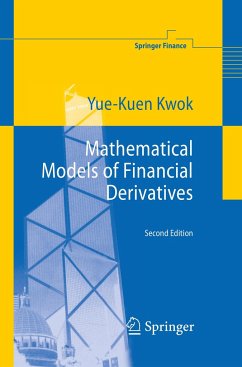
Mathematical Models of Financial Derivatives
Versandkostenfrei!
Versandfertig in 6-10 Tagen
53,99 €
inkl. MwSt.
Weitere Ausgaben:

PAYBACK Punkte
27 °P sammeln!
Objectives and Audience In the past three decades, we have witnessed the phenomenal growth in the trading of financial derivatives and structured products in the financial markets around the globe and the surge in research on derivative pricing theory. Leading financial ins- tutions are hiring graduates with a science background who can use advanced analytical and numerical techniques to price financial derivatives and manage portfolio risks, a phenomenon coined as Rocket Science on Wall Street. There are now more than a hundred Master level degree programs in Financial Engineering/Quantitativ...
Objectives and Audience In the past three decades, we have witnessed the phenomenal growth in the trading of financial derivatives and structured products in the financial markets around the globe and the surge in research on derivative pricing theory. Leading financial ins- tutions are hiring graduates with a science background who can use advanced analytical and numerical techniques to price financial derivatives and manage portfolio risks, a phenomenon coined as Rocket Science on Wall Street. There are now more than a hundred Master level degree programs in Financial Engineering/Quantitative Finance/Computational Finance on different continents. This book is written as an introductory textbook on derivative pricing theory for students enrolled in these degree programs. Another audience of the book may include practitioners in quantitative teams in financial institutions who would like to acquire the knowledge of option pricing techniques and explore the new development in pricing models of exotic structured derivatives. The level of mathematics in this book is tailored to readers with preparation at the advanced undergraduate level of science and engineering majors, in particular, basic profiiencies in probability and statistics, differential equations, numerical methods, and mathematical analysis. Advance knowledge in stochastic processes that are relevant to the martingale pricing theory, like stochastic differential calculus and theory of martingale, are introduced in this book. The cornerstones of derivative pricing theory are the Black-Scholes-Merton pricing model and the martingale pricing theory of financial derivatives.












